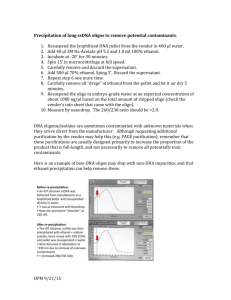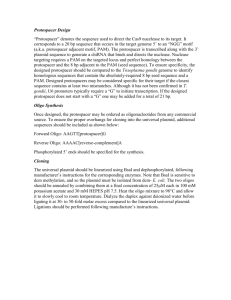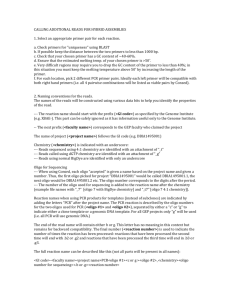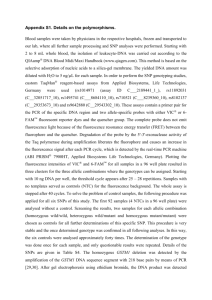bmfB13253Supplemary MaterialsChang
advertisement
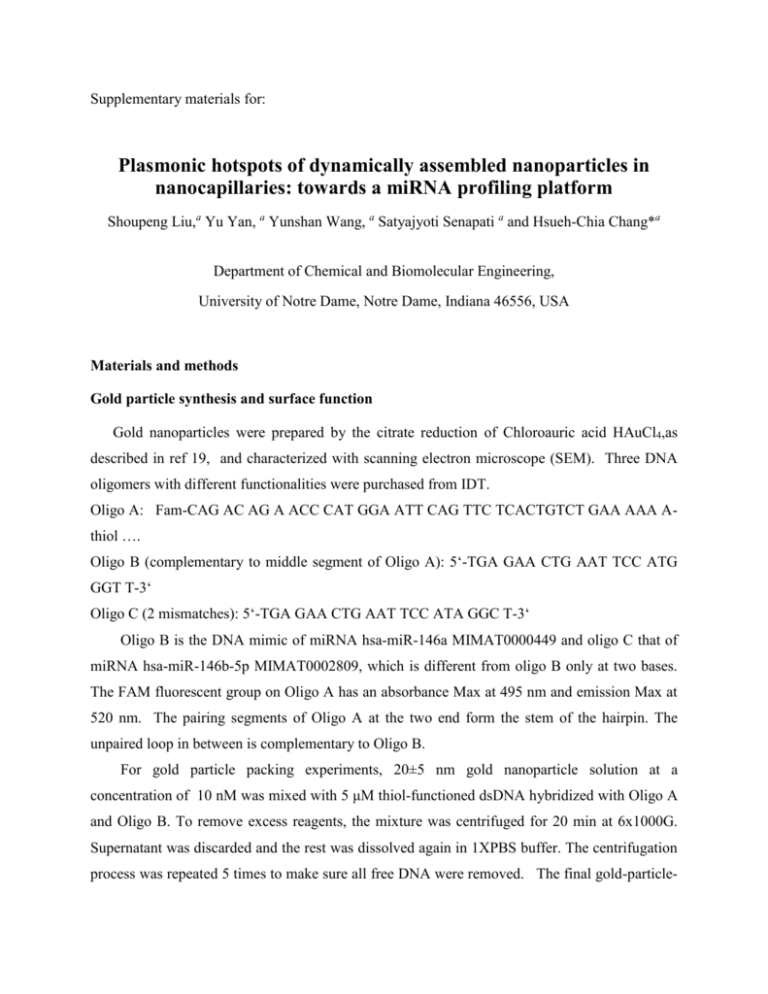
Supplementary materials for: Plasmonic hotspots of dynamically assembled nanoparticles in nanocapillaries: towards a miRNA profiling platform Shoupeng Liu,a Yu Yan, a Yunshan Wang, a Satyajyoti Senapati a and Hsueh-Chia Chang*a Department of Chemical and Biomolecular Engineering, University of Notre Dame, Notre Dame, Indiana 46556, USA Materials and methods Gold particle synthesis and surface function Gold nanoparticles were prepared by the citrate reduction of Chloroauric acid HAuCl4,as described in ref 19, and characterized with scanning electron microscope (SEM). Three DNA oligomers with different functionalities were purchased from IDT. Oligo A: Fam-CAG AC AG A ACC CAT GGA ATT CAG TTC TCACTGTCT GAA AAA Athiol …. Oligo B (complementary to middle segment of Oligo A): 5‘-TGA GAA CTG AAT TCC ATG GGT T-3‘ Oligo C (2 mismatches): 5‘-TGA GAA CTG AAT TCC ATA GGC T-3‘ Oligo B is the DNA mimic of miRNA hsa-miR-146a MIMAT0000449 and oligo C that of miRNA hsa-miR-146b-5p MIMAT0002809, which is different from oligo B only at two bases. The FAM fluorescent group on Oligo A has an absorbance Max at 495 nm and emission Max at 520 nm. The pairing segments of Oligo A at the two end form the stem of the hairpin. The unpaired loop in between is complementary to Oligo B. For gold particle packing experiments, 20±5 nm gold nanoparticle solution at a concentration of 10 nM was mixed with 5 μM thiol-functioned dsDNA hybridized with Oligo A and Oligo B. To remove excess reagents, the mixture was centrifuged for 20 min at 6x1000G. Supernatant was discarded and the rest was dissolved again in 1XPBS buffer. The centrifugation process was repeated 5 times to make sure all free DNA were removed. The final gold-particle- DNA complex was diluted to about 100 pM. It is estimated that about 200 oligomers were functionalized onto each gold particle surface. For microRNA biosensing experiments, the gold particles were functioned in the same manner except that only Oligo A was used instead of dsDNA from hybridized Oligo A and Oligo B. Nanopcapillary chip Commercial glass capillaries (Borosilicate Capillaries with OD1.0 mm and ID 0.78 mm; Warner Instruments) were pulled using laser-assisted capillary puller (Sutter Instrument Model P-2000, Laser-based micropipette puller). The capillaries were characterized with SEM and ion current measurements were carried out with each pulled capillary. Theoretical models(Yan et al, J. Chem. Phys, 138, 044705 (2013)) for the current and SEM characterization allow us to develop a pulling protocol for 100 nm tips. Capillaries with currents or images beyond 20% of the standard are discarded. Nanocapillary was embedded in a polydimethylsiloxane (PDMS) device which has two reservoirs, a base-side reservoir connected to the original mm-size capillary and a tip-side reservoir connected to the 100nm capillary tip. Ion current measurement and Optical imaging A schematic of our setup for simultaneous optical and ionic current measurements is shown in Fig. 1(a). PDMS device with embedded nanocapillary was mounted on a microscope (Olympus IX71). A tungsten lamp with a 480 nm filter was focused by a 60x air objective to excite fluorescent molecules. Fluorescence is collected via the same objective and reflected by a dichroic mirror (520 nm wavelength) to a CCD camera (Q imaging, Retiga EXL). We used a lower frequency than single NP resonance frequency in anticipation of dimers and aggregates. The maximum intensity corresponds to higher order aggregate modes with lower resonant frequencies than the single nanoparticle resonant frequency. A pair of Ag/AgCl electrodes are inserted into the two reservoirs. A source meter ( Keithley 2636A ) is used to apply a voltage and detect ionic current through the nanocapillary. In Au NP packing experiments, we first filled the base-side reservoir with 100 pM gold particles dispersed in 1X PBS buffer and the tip-side reservoir with pure 1X PBS buffer. The device was then refrigerated at 4 oC for 20 hours to allow diffusion of the gold particles into the capillary. To pack the particles at the end of capillary, 1V was applied to the electrodes for 10 min. For miRNA sensing, hairpin probe (Oligo A) functionalized Au NP was placed at the base side and the chip is refrigerated at 4 oC for 20 hours. Just before the experiments, a 100 μl solution of oligo B (miRNA target), with a concentration range between 0.1 fM to 10 nM, is placed in the tip-side reservoir. A negative voltage (-1V or otherwise stated) is then applied to drive the miRNAs into the capillary (trapping process) to hybridize with the hairpin probes on the NP in the capillary. A positive voltage (1V unless stated) is then applied immediately to pack the Au NPs towards the capillary tip. The process was monitored with fluorescence imaging. Detecting mismatched miRNA experiment was done in the same manner except Oligo C was used, with two different bases from Oligo B. The fluorescence signal is taken with illumination after 5 s. If the illumination is sustained, photo-bleaching is observed after 100 s and the short illumination is used to minimize photobleaching. Estimation of number of DNA entering the capillary The DNA electrophoretic flux can be simply estimated from the measured ionic current J C D carried by the dominant ions: DNA DNA DNA where I is the current (20nA), C D NA is the I /e C D . concentration, DDNA is the diffusion coefficient of 22 bases DNA with an estimated value of 2 1010 m2 / s , C and D are the concentration and diffusion coefficient of Na+ and Cl- (we 9 2 use 137mM NaCl for simplication of 1XPBS solution, DNa 1.3 3 1 0 m / s and DCl 2.0 3 1 09 m 2 / s ). Then the total number of DNA driven electrophoretically into the capillary in t=10mins can be estimated from the measured current of 20 nA. This estimate yields I C DNA DDNA t 0.03 , which means that electrophoresis is not the dominant a negligible N e C D component of the DNA flux. The other DNA transport mechanism is a transient diffusion process. This transient diffusion correspond to a relaxing diffusion front with a width corresponding to the diffusion length DDNA t and the total number of molecules that diffuse into the capillary over the time interval 2p 2p (DDNAt)3/2 N aCDNA = DDNA N aCDNAt DDNAt » 52 where N a is the Avogadro's 3 3 Number. We hence estimate about 50 DNA molecules have entered the capillary in 10 minutes. t=10 min is N = Fig. S1 The upper frames shows the white light images of the NP assembly dynamics and the lower frame shows the fluorescence image: (a) at 0 minute, no fluorescence signal is detected despite the presence of fluorescently tagged molecules. (b) at 1 minute, the NPs begin to assemble near the tip and produces a bright “hot spot” fluorescence signal; (c) at 15min, the particle is even more densely packed, but the fluorescence signal begins to fade. Fig. S2 (a) The fluorescence intensity as a function of the trapping time, at 3 min intervals. (b) The fluorescence intensity as a function of packing time (for a 10 min trapping time prior to packing), the concentration of target molecule is 10 pM. (a) 40 (b) Counts 30 20 10 0 10 15 20 25 Particle Diameter/nm 30 FIG.S3 (a) SEM image of functioned gold particles shows that most particles are monomers with a few dimers. (b) Histogram of the gold nanoparticle diameter from the SEM images. Fig. S4 Photobleaching with continuous exposure. The photobleaching time is about 100 s.

